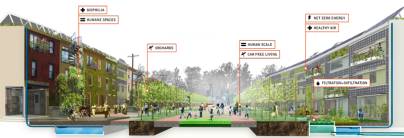
March 28, 2012
Two Green Building Initiatives Go Way Beyond LEED
“Patchwork”, Living City Challenge Entry The sustainability rating systems—Passive House, Living Building Challenge, and Net Zero (a subset of the Challenge)—appear in isolated new construction projects. The promise and perversity of trying to pick out sustainability targets, building by building, within a tightly woven urban fabric can be examined in Philadelphia. Here, the architecture/development dynamo […]
“Patchwork”, Living City Challenge Entry
The sustainability rating systems—Passive House, Living Building Challenge, and Net Zero (a subset of the Challenge)—appear in isolated new construction projects. The promise and perversity of trying to pick out sustainability targets, building by building, within a tightly woven urban fabric can be examined in Philadelphia.
Here, the architecture/development dynamo Onion Flats proposes to build the first passive house. They have an option to buy a tract of land from the city (at a presumably attractive, though not-yet-agreed-upon price) to develop into a fairly large mixed-use project. As you would expect, the upfront cost of a premium Passive House project stops many developers before bothering to open Excel. At a typical 10%-20% premium, which takes 10-15 years to recoup, it’s not surprising that so far only die-hard homeowners and affordable housing CDCs have been the early adopters.
But if anyone can pull off the project, it would be the folks at Onion Flats as they will act as architects, builders, prefab manufacturers, and real-estate agents. With the ability to pool the profit slices that each of these services take, they just might be able to get the project down to a reasonable cost. And as a team of brothers, they take integrated project delivery to a genetic level.
What about Living City Challenge? Team Olin of Philadelphia (comprised of Olin, Digsau, and Interface) won the Cities That Learn Award for their entry, Patchwork, an impressive effort that proposes noteworthy ideas for ways to handle energy and water infrastructure in the gritty city. Patchwork also shines the light on some serious flaws of the Living Building Challenge (LBC) in an urban context. Closed loop energy and water systems can work for a relatively small building surrounded by undeveloped land, as has been demonstrated by LBC case studies. Indeed, closed loop water systems function well in many parts of rural America. However, the building/site as self-sufficient unit is of debatable merit in an urban context.
The building-by-building energy focus of the LBC may keep a fair portion of urban structures out of the game, as well as cause some serious pain on the other side of the “net” equation—the traditional electric grid. The Challenge demands renewable energy production without carbon emissions; its case studies all go with solar electricity and use the municipal grid as their storage battery. If every building in a city met the Challenge, the dirty-old-thermal-electric grid would receive big dumps of electricity on sunny days and huge electricity draws each night and cloudy day. Efficiency losses associated with the traditional grid rapidly and unpredictably powering up and down could potentially offset the carbon-emission reductions associated with solar electricity. And, because the Challenge demands net-zero energy at the building level, an urban row house with a tiny footprint, tinier yard, and two hours of sun load just can’t compete.
“Patchwork”, Living Machine and storm water infiltration planters
A large scale for renewable energy production and transmission may be more efficient than a building-unit scale. Unpredictable wind/solar grid loads even out some over larger areas. If that little row house can run off renewable wind energy produced 100 miles away, isn’t the greater goal of carbon-neutral energy served? Then again, if technology in battery storage advances, instead of net zero, a building could shoot for off the grid.
How about local closed loop water? Olin’s Richard Roark convincingly argues that the neighborhood scale works best for water infrastructure. As with energy, a critical first move demands minimizing waste—which hinges on greywater reuse when it comes to water—the old don’t-flush-the-toilet-with-drinking-water point. Once potable water needs have been reduced, imagine big cisterns capturing rainwater to satisfy demand. In Philly we have so much storm water that infiltration becomes critical—think permeable surfaces and drinking plants. Then—the doozy—local blackwater treatment at your friendly neighborhood sewage treatment facility, the “Living Machine” that brings the liquids to greywater standards for local reuse and leaves the solids ready to plow into your urban garden, through attractive sweet-smelling wetland environments.
“Patchwork”, street infrastructure
Passive House and Living Building Challenge describe elegantly simple concepts—a welcome relief from the cumbersome LEED rating system. Passive House lays out a proven, pragmatic approach grounded squarely in energy reduction. The Living Building Challenge attempts a paradigm shift in how we conceive buildings. While some serious kinks need to be worked out in the urban application of the system, some serious kinks also need to be worked out in modern civilization; it takes a bold goal to get bold results. The Challenge forces a drastic reduction of energy and water waste—obvious first steps toward sustainability. The system also forces implementation of known alternative energy systems that help demystify existing technologies and encourage technological innovation, critical to kick-start new energy technologies.
The Living Building Challenge as currently described forces us to take responsibility for our consumption. Perhaps the next iteration of the Challenge will push us to the next level—to foster conscientious interdependence at the scales critical to an urban network.
Juliet Whelan owns Jibe Design, an architecture firm which focuses on contemporary sustainable design.






